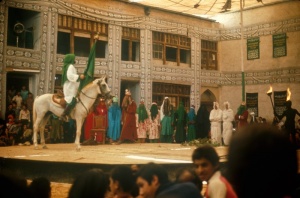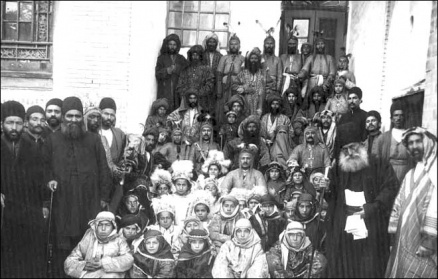Ta'ziya
| TAZIYA (TA`ZIYEH) | |
|---|---|
 Ta‘zīye (or Ta’azyeh) is a ritual dramatic art that recounts religious events, historical and mythical stories and folk tales. | |
| Originating culture | Inscribed in 2010 (5.COM) on the Representative List of the Intangible Cultural Heritage of Humanity |
| Originating era | Asia and Australasia |
Ta'ziya is an Islamic Shi'ite ritual performed mainly in Iran. The Arabic term ta'ziya (Per., Ta'ziyeh) means to mourn or to offer one's condolences for a death. It is also sometimes called ta’ziya khani, or shabih khani. The term taʻziya has been used primarily in Iran to refer to a Shi'ite religious ritual consisting of a theatrical re-enactment of the tragic seventh century Battle of Karbala. This historic battle was fought between the followers of prophet Muhammad's grandson, Imam Husayn and the troops of the second Umayyad caliph Yazid. While taʼziya performance rituals have been mostly restricted to Iran, the Shi'a of South Asia and Iraq use the term taʻziya to refer to a model or replica of Husayn's tomb, which they use in their ritual processions, after which they are ritually discarded.
The Battle of Karbala
Accounts of the Battle of Karbala can be summarized as follows. In the year 680 C.E., Husayn, who was also the third imam of the Shi'a, was killed in the desert of southern Iraq along with over seventy of his family and close friends by troops loyal to the caliph Yazid. The women and children were taken prisoner and paraded in various cities, adding to the humiliation, but also providing opportunities for these women, particularly Husayn's sister Zaynab, to speak out publicly against Yazid. Yazid is portrayed by the Shisa as notoriously corrupt, immoral, and oppressive. Hence, Husayn's rebellion and subsequent martyrdom is understood by the Shiʻa as an epic struggle between good and evil. For the Shisa this event has served as a vindication of the Shi'ite cause in the face of Sunni criticism, as well as constituting the central event in their understanding of human history.
Historical Development
Following the battle itself, popular elegies of the martyrs were composed. However, the earliest reliable account of the performance of public mourning rituals was recorded in 963 C.E. during the reign of Mu'izz al-Dawla, the Buyid ruler of southern Iran and Iraq. When the Safavid dynasty came to power in Iran a new type of ritual called rawza-khani emerged, consisting mainly of a ritual sermon recounting and mourning the tragedy of Karbala. This ritual was based on texts like Husayn Va'ez Kashfi's 1502 composition entitled Rawzat al-shuhada (The garden of martyrs). Kashfi's text was a synthesis of a long line of historical accounts of Karbala by religious scholars. By the time the Qajar dynasty took power in Iran in 1796, the rawza-khani ritual had evolved into the much more elaborate ritual called shabih-khani or taʼziya. The ta’ziya, an elaborate theatrical performance of the Karbala story based on the same narratives used in the rawza-khani, involved a large cast of professional and amateur actors, a director, a staging area, costumes, and props.
The heyday of ta'ziya was the Qajar era (1796–1925). The most elaborate example of Qajar patronage of taʻziya was the Takiya Dawlat, which was built in Tehran in 1873 by the order of the Iranian monarch Naser al-Din Shah. This takiya was built on a very grand scale. Nevertheless, it was in most ways a typical takiya. It consisted of a large circular amphitheater with several entrances surrounding a large open area; a tent was used as a roof. Its primary purpose was to provide a staging area for the most elaborate ta’ziya performances. Lady Sheil, a European traveler, resident in Tehran in 1856, gives a brief account of the taʻziya performance in the Takiya Dawlat in 1856, concluding, “It is a sight in no small degree curious to witness an assemblage of several thousand persons plunged in deep sorrow, giving vent to their sorrow” (p. 127).
Modern Trends
Following the fall of the Qajar dynasty in the early twentieth century, the ta'ziya slowly declined until it was mostly abandoned in the large cities in the 1930s and 1940s. However, ta'ziyas have continued to exist in Iran on a smaller scale throughout the twentieth century, especially in traditional sectors. There were two reasons for this relative decline. The first Pahlavi king, Reza Shah, outlawed the ta’ziya. More importantly, as Iranian society changed modernized elites became less interested in sponsoring such traditional ritual events. Scholars of literature and drama as well as government agencies attempted to preserve this theatrical tradition in the 1970s, and again in the 1980s and 1990s. However, unlike the Qajar period, which was the heyday of the taʻziya ritual, the dominant public rituals since the 1930s have been the Muharram processions, and various forms of the rawza khani.
Bibliography
- Chelkowski, Peter, ed. Ta'ziyeh: Ritual and Drama in Iran. New York: New York University Press, 1979.
- Hegland, Mary Elaine. “The Majales-Shiʻa Women's Rituals of Mourning in Northwest Pakistan.”
- In A Mixed Blessing: Gender and Religious Fundamentalisin Cross Culturally. Edited by Judy Brink and Joan Mencher. New York and London: Routledge, 1997.
- Pelly, Sir Lewis. “The Miracle Play of Hasan and Husayn.” Collected from Oral Traditions. London: Wm. H. Allen and Co., 1879.
